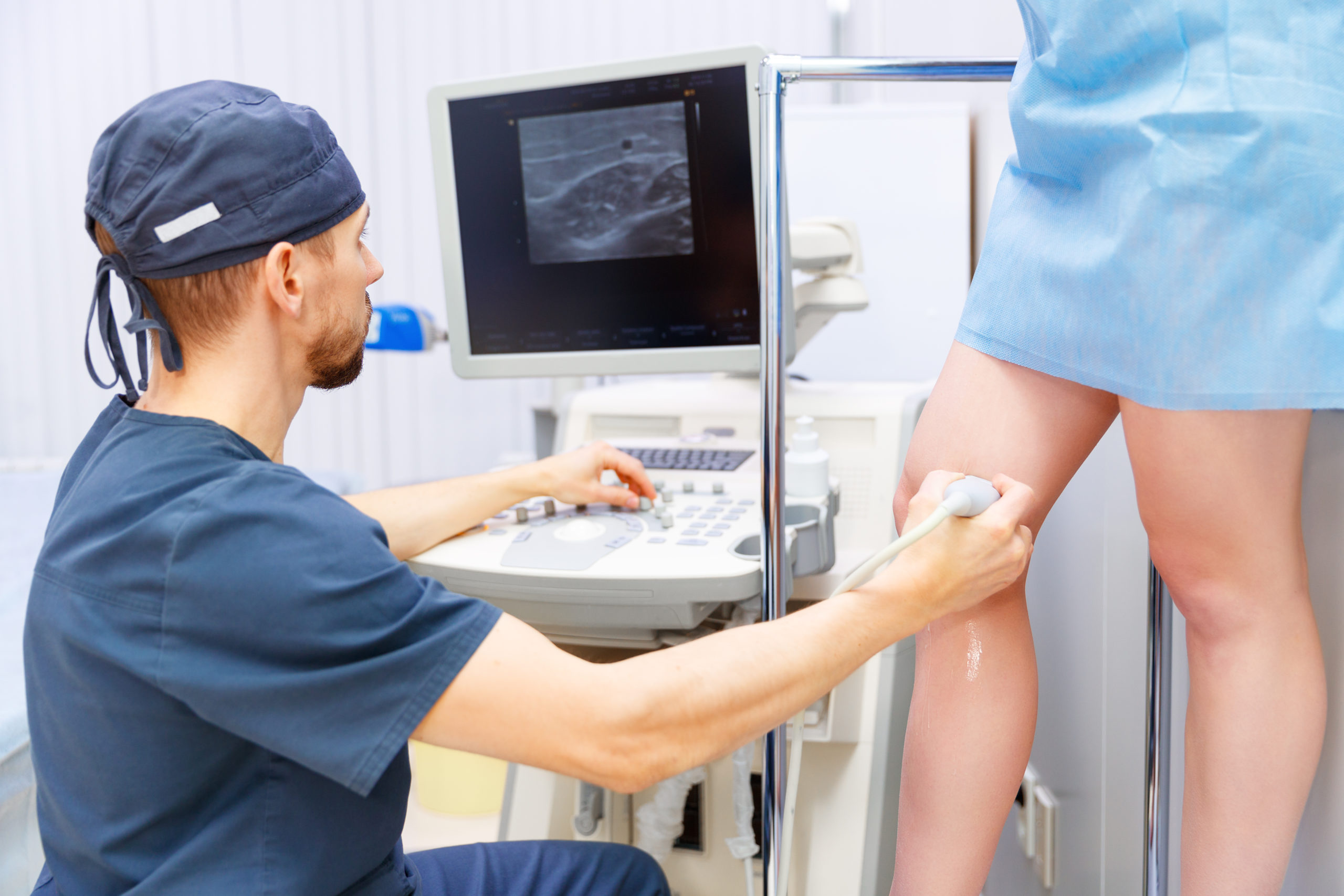Deep vein thrombosis (DVT) is a condition that can happen when a blood clot forms in one of the deep veins in your body, typically in your legs. It occurs when blood flow slows down or becomes stagnant, allowing a clot to form.
Think of your veins as tubes that carry blood back to your heart. When a clot forms, it can partially or completely block the flow of blood through the affected vein. This can lead to swelling, pain, and sometimes a warm sensation in the affected leg.
DVT is important to recognize and treat because if the clot breaks free, it can travel through your bloodstream and potentially cause a blockage in your lungs, known as a pulmonary embolism, which can be life-threatening.
- Leg pain: You may experience persistent pain, tenderness, or cramping in your leg. The pain is often described as a deep ache or a feeling of soreness.
- Swelling: The affected leg may swell, causing noticeable enlargement. This swelling may occur in the entire leg or just in certain areas.
- Redness and warmth: The skin over the affected area may become red, and the leg may feel warm to the touch.
- Skin discoloration: In some cases, the skin may appear bluish or have a reddish-purple hue.
- Vein visibility: The affected vein may become more prominent and visible, appearing as a cord-like structure beneath the skin.
- Prolonged immobility: Extended periods of inactivity, such as long-distance travel, bed rest, or sitting for long hours without movement, can increase the risk of DVT.
- Surgery or injury: Certain surgeries, particularly those involving the lower extremities or abdomen, can increase the risk of blood clot formation. Additionally, major injuries or fractures can also contribute to DVT development.
- Medical conditions: Certain medical conditions like cancer, heart disease, lung disease, and inflammatory bowel disease can increase the risk of DVT.
- Hormonal factors: Hormonal changes caused by pregnancy, birth control pills, hormone replacement therapy, or estrogen therapy can make the blood more prone to clotting.
- Age: The risk of DVT increases with age, especially over 60 years.
- Obesity: Excess weight puts additional pressure on the veins, impairing blood flow and increasing the risk of clot formation.
- Family history: Having a close family member who has had DVT or a clotting disorder increases the likelihood of developing DVT.
- Smoking: Smoking damages the blood vessels and increases the risk of clotting.
- Varicose veins: Varicose veins, which are swollen and twisted veins, can increase the risk of DVT.
- Previous history of DVT: If you have had a previous episode of DVT, you are at a higher risk of developing it again.
It's important to note that having one or more risk factors does not guarantee that you will develop DVT, but it increases the likelihood. If you experience any symptoms or have concerns about your risk call our office to schedule a consultation.
Pelvic Congestion Syndrome is a condition that affects women, typically in their reproductive years. It happens when the veins in the pelvis, which are the blood vessels that carry blood back to the heart, become enlarged and stretched. This can cause pain and discomfort in the lower abdomen, pelvic area, and even in the legs.
Think of it like a traffic jam in your veins. Normally, blood flows smoothly through the veins, but in Pelvic Congestion Syndrome, the blood gets stuck and starts to pool in the pelvic area. This pooling of blood puts pressure on the surrounding tissues and can lead to pain.
The exact cause of Pelvic Congestion Syndrome is not always clear, but it can be related to hormonal changes, pregnancy, or previous damage to the veins. Some women may be more prone to this condition due to genetic factors.
- Chronic pelvic pain: This is the main symptom of Pelvic Congestion Syndrome. The pain is typically described as a dull, aching sensation in the lower abdomen or pelvic area. It may come and go or be present all the time. The pain may worsen after standing or sitting for long periods and may improve when lying down.
- Pain during or after sexual intercourse: Some women with Pelvic Congestion Syndrome experience pain or discomfort during or after sexual intercourse. This can be due to the increased blood flow and pressure in the pelvic area.
- Pelvic heaviness or pressure: Many women with this condition describe a feeling of heaviness or pressure in the pelvic region. It may feel like something is weighing down on the pelvis.
- Varicose veins in the pelvic area: In some cases, visible varicose veins may develop in the vulva, buttocks, or upper thighs. These are swollen and enlarged veins that can be seen beneath the skin.
- Worsening of symptoms during certain times: Symptoms of Pelvic Congestion Syndrome may worsen during or after menstrual periods, pregnancy, or prolonged standing or sitting. Hormonal changes and increased blood volume during pregnancy can exacerbate the condition.
It's important to note that these symptoms are not exclusive to Pelvic Congestion Syndrome and can be caused by other conditions as well. If you are experiencing any of the above, take the first step towards finding relief and call our office for an appointment. Let our physicians get you on the path towards managing your symptoms and improving your quality of life.
May-Thurner Syndrome is a condition that affects the blood vessels in your legs. Let's imagine that the blood vessels in your legs are like two tubes running next to each other. In May-Thurner Syndrome, one of these tubes (the vein) gets squeezed by the other tube (the artery).
This squeezing can cause problems because it makes it harder for blood to flow through the vein properly. It can lead to blood clots forming in the affected vein, which can be dangerous.
- Leg pain or discomfort: You may experience pain, aching, or a feeling of heaviness in your leg, especially in the thigh, calf, or lower leg. The pain might be persistent or occur intermittently.
- Swelling in one leg: One leg may appear noticeably swollen or larger than the other. This swelling can be caused by the restricted blood flow in the affected vein.
- Leg fatigue or heaviness: You may feel tiredness or a sense of heaviness in the affected leg, particularly after standing or sitting for prolonged periods. This can be due to inadequate blood circulation.
- Skin changes: The skin over the affected leg may show signs of discoloration, such as a reddish or bluish tint. It might also feel warmer to the touch compared to the other leg.
- Visible veins: In some cases, you might notice the appearance of prominent or bulging veins in the leg affected by May-Thurner Syndrome. These veins may be more visible or dilated than usual.
- Deep vein thrombosis (DVT): May-Thurner Syndrome can increase the risk of developing blood clots in the affected vein. If a blood clot forms, it can lead to symptoms such as sudden, severe pain, swelling, warmth, and redness in the leg. DVT is a serious condition that requires immediate medical attention.
If you have persistent leg symptoms or suspect you may have May-Thurner Syndrome, it's essential to discuss your concerns with a physician who can conduct appropriate evaluations, diagnostic tests, and recommend an appropriate treatment plan. Call our office today for your appointment.
CVD refers to other chronic conditions related to or caused by veins that become diseased or abnormal. These problems can include:
- Varicose Veins & Spider Veins
- Leg Swelling
- Leg Pain, heaviness, aching and fatigue
- Leg Skin Changes
- Chronic Venous Insufficiency
- Non healing ulcers in the legs
- Inflammation or infection in the veins (phlebitis)
Medical Treatments
Compression stockings are a mainstay of varicose vein treatment. The stockings compress the legs and the leg veins to reduce the backflow of blood towards the feet.
Surgical Treatments
Surgical treatments including ligation and stripping are rarely used for treatment after the development of endovenous therapies. Surgery may require multiple incisions to remove and ligate the affected veins.
Pelvic congestion syndrome
May-Thurner syndrome
Deep Venous Thrombosis (DVT)
A thrombosis is a blood clot. A deep vein thrombosis (DVT) refers to a blood clot in the leg that does not travel to other parts of the body.
Chronic Venous Disease (CVD)
CVD refers to other chronic conditions related to or caused by veins that become diseased or abnormal. These problems can include:
- Varicose Veins & Spider Veins
- Leg Swelling
- Leg Pain, heaviness, aching and fatigue
- Leg Skin Changes
- Chronic Venous Insufficiency
- Non healing ulcers in the legs
- Inflammation or infection in the veins (phlebitis)



